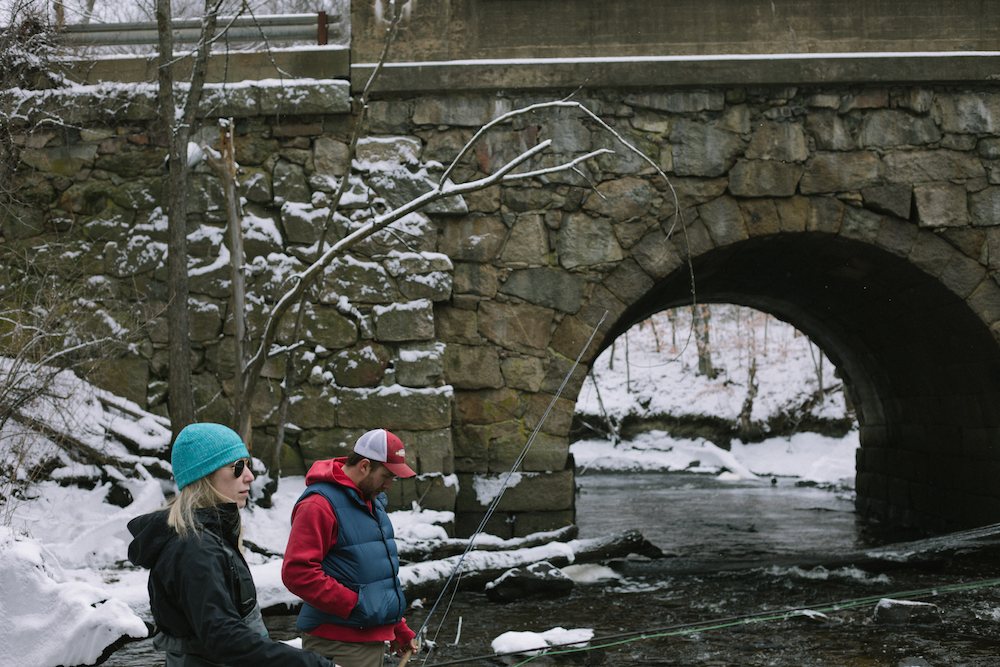I was out at Pyramid Lake recently, and after the first full day of fishing found myself at the bar in Sutcliffe, Nevada with my buddy Tim Johnson (the fly fishing artist) and our guide Ryan Dangerfield. Ryan was working his way through a Jack and Coke that was almost all Jack and no Coke while Tim and I sipped on water. Neither of us drink.
It was while we were sitting at the bar and waiting for our ribs and wings to arrive that I commented to Ryan that he’s got to like guiding in a place like Pyramid in the winter.
“The fish still eat big flies,” I said. “It’s not like out on the Provo or the Green sometimes when they want those tiny 22 midges.”
We all toasted to that; after all, we’d just spend an entire day in December fishing giant streamers and huge nymphs for trophy cutthroat trout. I’d likely have fished a different rig if Ryan hadn’t guided us that day, but that’s what you pay a guide for. It helps eliminate the learning curve.
Ryan also guides on the Utah section of the Green River, and we’re both intimately familiar with how picky those fish can be at times. But we’ve both fished that river more than most, so it doesn’t feel like such a challenge to figure out what the fish are eating on any given winter day.
But what if you’re out fishing a new piece of water this winter? It’s not enough to know the patterns that work best on any given river. You need to know what they’re eating to increase your catch rate while on the water.
With that in mind, let’s look at a few tips to help you better understand trout feeding patterns during the coldest part of the year.

Trout Are Lazy
The most important thing to remember about trout in winter is that, for the most part, they’re lazy. Now, there’s no such thing as a universal truth in fly fishing, but this is pretty damn close to it. Water temperature and flows drop, hatches are sparse, and most fish are exhausted after an energetic spawning season.
This is the time of year when trout stack up in long riffles and well-oxygenated pools. They do this for two reasons:
- Swimming on the riverbed in a run or pool with a swift current delivers a steady stream of oxygen
- That same position within the water column pushes plenty of food to the trout, which means they don’t have to expend much energy to eat
Those two points hold true for fly fishing most of the year, but they’re especially important in the winter. With fewer bugs available on the menu, trout aren’t going to spend the energy chasing a size 12 caddis on the surface – usually (I did catch some browns on hoppers right at the end of November, though).
Remembering where the fish are at helps you recognize what they’re eating. For example, if you’re out on a piece of water like the Middle Provo River – one of the rivers that taught me to fish – you’ll see a steady stream of midges hatching. In the pools you’ll get smaller trout rising to those midges, but the majority of trout are taking flies well below the surface.
So instead of attempting to match the duns that’ve hatched, match their first stage – the pupa. My prom pupa pattern (available in the upcoming Rocky Mountain Region Postfly Box) delivers consistently during the winter because it presents fish with a recognizable, easy-to-eat food source.
Check the Rocks
It’s a time-honored tradition for me – whenever I fish new water, I pick up a few rocks to see what flavor of caddis or mayfly is around. During the winter, the number of bugs on the rocks is fewer, but the simple act of looking at those insects tells you quite a lot.
First, it distills the river down to its roots. The bugs you see in the winter are often the mainstay bugs trout will eat year-round. If you’re seeing a lot of stonefly nymphs in the winter, tie one on. It’s not really stonefly season, but if the nymphs are there the trout are likely eating them.
I love winter fly fishing. There are few things as relaxing or enjoyable as a day on the water with nothing but falling snow and softly rising trout for company. If winter kicks your can, take these tips with you the next time you hit the water. You might be surprised at how well you’re able to do.
Spencer Durrant is a fly fishing writer, outdoors columnist, and novelist from Utah. His work has appeared in Field & Stream, Hatch Magazine, Sporting Classics Daily, and other nationally-recognized publications. You can find him on Twitter/Instagram @Spencer_Durrant.



3 thoughts on “Fish Food 101: How to Tell What Trout Are Eating in the Winter”